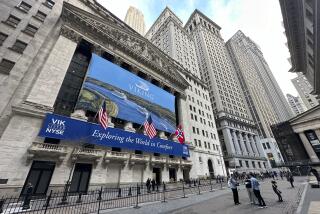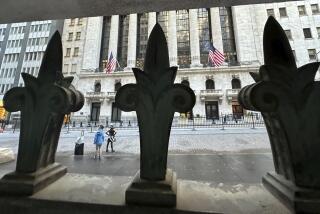Bond Analysts Advise Caution
Federal Reserve Chairman Alan Greenspan caused a commotion a week ago when he warned in unusually clear language that interest rates would keep going up.
But to Wall Street, Greenspan’s warning looks like a half-truth: Though short-term rates are indeed on the rise, long-term rates have been flat or falling.
That split performance has given a financial boost to consumers. It means they’re earning more interest on money market accounts and other short-term savings. At the same time, mortgage rates mostly have been holding steady for the last three months, keeping the housing market strong.
Many companies also have benefited. They’ve been able to issue long-term bonds this fall at yields that in some cases have been the lowest in more than a decade.
The question that looms large over the economy and financial markets is whether long-term interest rates can remain subdued if short-term rates continue to climb at the hands of the Fed.
Some Wall Street pros say investors who are buying long-term bonds at current rates may not realize how much they could lose, at least on paper, if long-term rates should rise.
“I think the bond market is wrong to think long-term yields aren’t going up,” said Alfred Kugel, senior investment strategist at Stein Roe Investment Counsel in Chicago.
But other analysts say bond yields could go lower, rather than higher, in 2005 -- which would mean that buying bonds now could be a smart investment move.
In the case of short-term rates, there is little doubt about what’s coming next: When Fed policymakers meet Dec. 14, they are widely expected to raise their bellwether short-term rate for the fifth time since June, from 2% to 2.25% -- which would be a three-year high.
The Fed has lifted its key rate from a generational low of 1% amid more signs that the U.S. economy is on a sustainable growth track. Greenspan and other Fed officials have signaled that they planned to continue raising short-term rates at a “measured” pace as long as the economy is expanding.
Historically, short- and long-term interest rates have mostly tended to move in the same general direction. But there are times when their trends diverge.
That can happen because although the Fed controls short-term rates, long-term rates are set by investors in the global marketplace.
Since June 30, when the Fed raised its key rate for the first time, the yield on the 10-year Treasury note, a benchmark for mortgage rates, has fallen from 4.58% to 4.20% as of Wednesday.
The average yield on an index of corporate junk bonds has tumbled from 7.69% to 6.44% in the same period, and the average 30-year mortgage rate, which tracks long-term bond yields, has fallen from 6.25% to 5.72%.
The declines in long-term rates in part reflect relief that the Fed hasn’t tightened credit more quickly, analysts say. In spring, as nervous investors wondered and worried about what the Fed might do, the 10-year T-note yield shot as high as 4.87% by mid-June.
Other factors also have put downward pressure on long-term rates in recent months.
One is the surge in oil prices, from $37 a barrel at midyear to about $50 now. Some bond investors have bet that high energy prices could cause the economy to slow markedly in 2005, in turn causing the Fed to pause in its credit-tightening campaign.
“I think the bond market is forecasting that the economy is slowing quite a bit,” Kugel said, adding that he didn’t share that belief.
Continuing worries about a possible terrorist attack on U.S. soil also have dragged Treasury bond yields lower, analysts say. Investors have been willing to accept lower yields in return for the relative safety of Treasuries should a calamity occur.
In the corporate bond sector, a relatively modest level of borrowing by companies this year has meant a limited supply of new bonds. So yield-hungry investors have had to compete more aggressively to get a piece of new offerings or to buy bonds from other investors. That has pulled yields down.
“There is a lot of money coming into the bond market, and no one wants to sell” what they have, said Kingman Penniman, head of junk bond research at KDP Investment Advisors in Montpelier, Vt.
But the biggest reason long-term interest rates have declined since June may be that investors trust that inflation won’t rise significantly in the years ahead, experts say.
Inflation is the No. 1 enemy of fixed-rate bonds because it erodes the purchasing power of money over time.
“There is strong confidence in the ability of the Fed to contain inflation,” said Ralph Axel, government bond strategist at HSBC Securities in New York.
Indeed, the central bank has said one of its principal goals in raising short-term rates is to make sure the economy doesn’t overheat and drive up inflation from the current annualized pace of about 2%.
Market pros like Kugel, however, worry that current long-term yields are too low given what could go wrong for bonds -- for example, higher-than-expected inflation in 2005 because of rising energy costs or because of higher prices of imported goods as the dollar’s value sinks.
What’s more, Treasury bonds have benefited from heavy buying by foreign investors in recent years. Greenspan, in comments last week in Germany, warned that foreigners’ interest in U.S. bonds could wane as the dollar weakens and devalues their holdings.
An unanticipated jump in borrowing by companies next year also could quickly drive up long-term bond yields, said John Lonski, economist at Moody’s Investors Service in New York.
He and other economists say Greenspan’s surprisingly direct language last week should serve to remind bond investors of the risks they face in accepting current long-term yields.
The Fed chief, speaking somewhat tongue in cheek to his German audience, said that those who weren’t hedging their bets against rising interest rates were “desirous of losing money.”
A rise in yields on new bonds would automatically drive down the market value of older bonds paying lower fixed rates.
Yet some market pros say long-term bond yields are higher than they should be compared with short-term rates, judged against recent history.
With the Fed’s key rate at 2% and the 10-year T-note at 4.20%, the “spread” between the two is 2.2 percentage points. By contrast, the mean difference between the two rates was 1.7 points between 1993 and 1997, when the economy was growing at a healthy pace, Moody’s data show.
Michael Cosgrove, economist at Econoclast Inc. in Dallas, believes that long-term yields could move lower, rather than higher, if investors remain confident that the Fed can go slow in raising short-term rates in 2005.
And the Fed may have no choice, Cosgrove said, because “it may take another one or two years of low short-term interest rates to help heal the [economy’s] wounds” from the downturn at the beginning of the decade.
Lonski agreed that the difference between short- and long-term rates was relatively wide. Still, he said, given the risks the bond market faces, investors should be cautious about loading up on bonds at current yields.
“Wherever you look in the bond market, you can make an argument for overvaluation,” Lonski said.
More to Read
Inside the business of entertainment
The Wide Shot brings you news, analysis and insights on everything from streaming wars to production — and what it all means for the future.
You may occasionally receive promotional content from the Los Angeles Times.










